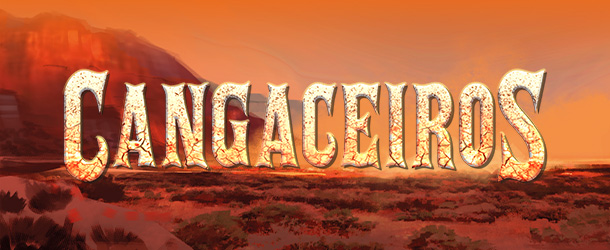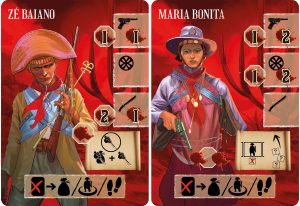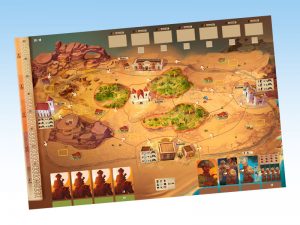Set in Brazil in the late 1800s and early 1900s, Cangaceiros brings to the tabletop an historical period never told before, in a deep and extremely re-playable game. In this article, originally published by Meeple Monthly Magazine, issue 108 (March 2023), the author Roberto Pestrin shares his notes about the creation and development of the game. Pestrin is an Italian game designer, attending IdeaG, a circuit of events dedicated to game designers, since 2007. His first game, “Dojo Kun”, was published in 2015, followed in 2018 by “Kick Ass”, a work based on the namesake comic and designed with Hjalmar Hach and Maurizio Vergendo.
"Cangaceiros comes from the mind of Marco Vassallo, a big expert of everything related to the “cangaceiros”, the legendary Brazilian bandits of 19th-20th century. His passion for the theme “infected” the game publisher Ergo Ludo Editions so much that they asked me to turn that story into a game, believing that I was the right designer for this kind of challenge.
At first, I didn't know the setting and, after studying it, I discovered a very “Tarantinian” and pulp world that captured my mind. The “cangaço” was a phenomenon of social banditry that affected Brazil from 1870 to 1940 and which saw peasants and ordinary people become bandits, to rebel against the abuses from large landowners (coronéis) who oppressed the scattered farms in the Brazilian “Sertão”, a rather hostile territory. The life of the cangaceiros was a struggle for survival by affirming an ideal of justice with machetes (facão) and thus engraving their legendary names in the history of Brazil.
With the aim of creating a game imbued with such a strong theme, I identified five key concepts that have been present since the very first prototype: characters, gang, nasty gameplay, territory, and survival.
The concept of cangaceiros as real "characters" immediately emerged in an important way as in the chronicles of that time these bandits identified themselves in a precise manner, each of them had distinct characteristics and personalities. They are very much like the main characters of an action film with a pulp setting. To recreate this aspect in the game, each player manages a gang of cangaceiros led by a chief, who due to his unique characteristics can influence the approach to the game. Also, in the history as in the game, not all cangaceiros die in battle, but some of them return to ordinary life, abandoning the dangerous life of a bandit.
Another key aspect was the "gang": The leaders gathered under themselves real gangs with which they carried out a sort of guerrilla warfare to counter the overwhelming power and abuse of the “volantes” namely the patrols of the coronéis, the landowners' militias.
The gang thus becomes a key element of the game that the players must manage by improving their performance through the acquisition of new members and the improvement of their action cards, with the aim of facing off the best the volantes.
The cangaceiros were in constant conflict with the volantes. Sometimes they directly attacked them, other times the volantes were the ones who ambushed the cangaceiros chiefs when they least expected it. In these clashes, there was no shortage of low blows, betrayals, and tips against other cangaceiros. I tried to transpose this tension into the game by dividing the round into two main parts: in the first part the players attack the volantes, while in the second part the volantes try to track down all the cangaceiros. As in history, even in the game it is possible to manipulate the actions of the volantes against the opponents.
Another "main character" of these events is the territory, the Sertão, the inhospitable Brazilian desert, within which there were particularly impervious areas such as the caatinga, a gray and dry forest, where government patrols initially did not even dare to enter. It was a harsh territory in which the cangaceiros had learned to survive and where they took refuge to escape the volantes. Hence the need to move the game elements on a stylized map of that desert and to make sure that the game experience is "poor in resources" and full of tension.
A further key ingredient of this game is the constant struggle for survival. This constant "effort" of living and fighting has been gradually refined thanks to the developers, Daniele Ursini and Lorenzo Maria Conti, evolving the gameplay to create a game engine based on the management of a deck made up of seven cards. With these cards, all the actions can be executed, some can even be permanently replaced.
The work on Cangaceiros was an exciting journey that began in 2017, fueled by constant dialogue with the publisher to give the right soul to the game. As already mentioned, Daniele Ursini and Lorenzo Maria Conti took care of the final development, making the adjustments that allowed Cangaceiros to become what it is now. It's not up to me to say whether it's good or bad from a mechanical point of view, but I can certainly assure you that aesthetically the game is a blast. Ergo Ludo Editions publisher has hired Emiliano Mammucari, an exceptional artist borrowed from the world of comics. He was able to characterize the game by making the cangaceiros bosses “alive”, modern, and speaking through the illustrations that I loved right away and which, I am sure, will also be loved by the players".












